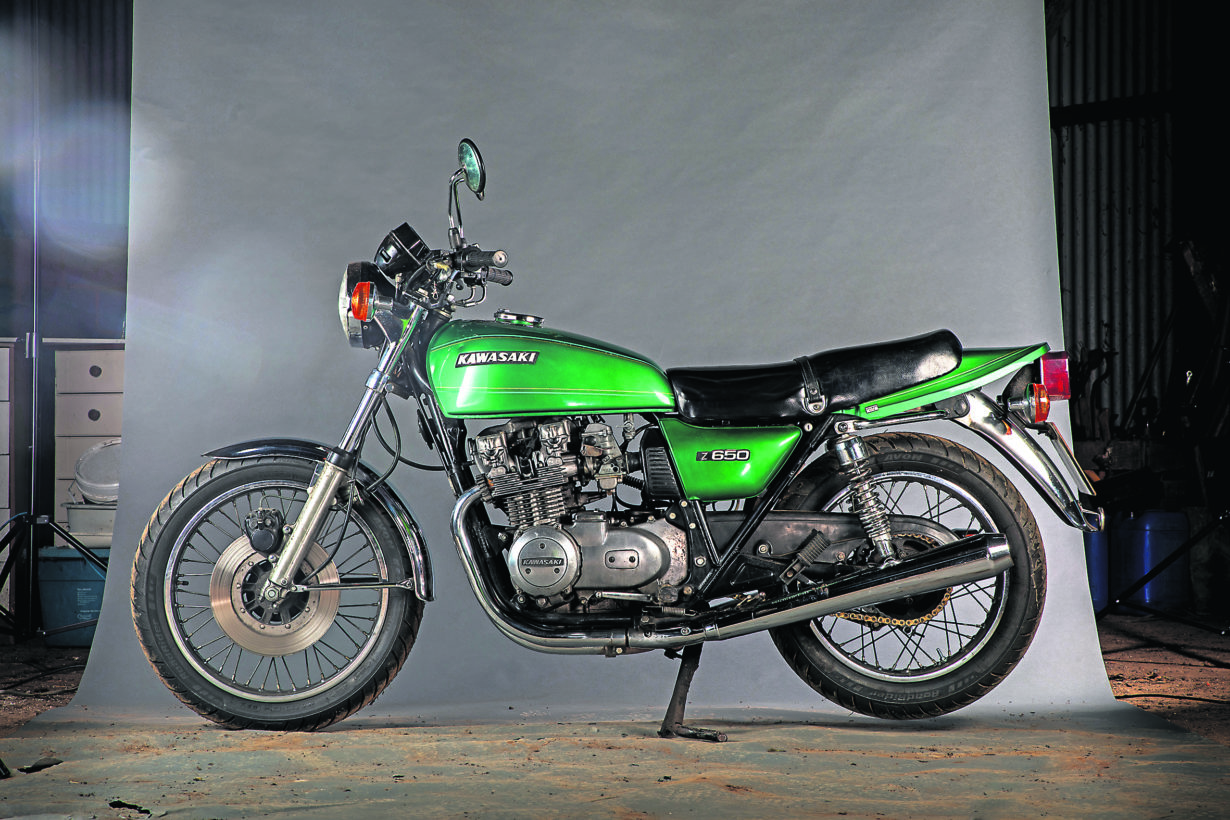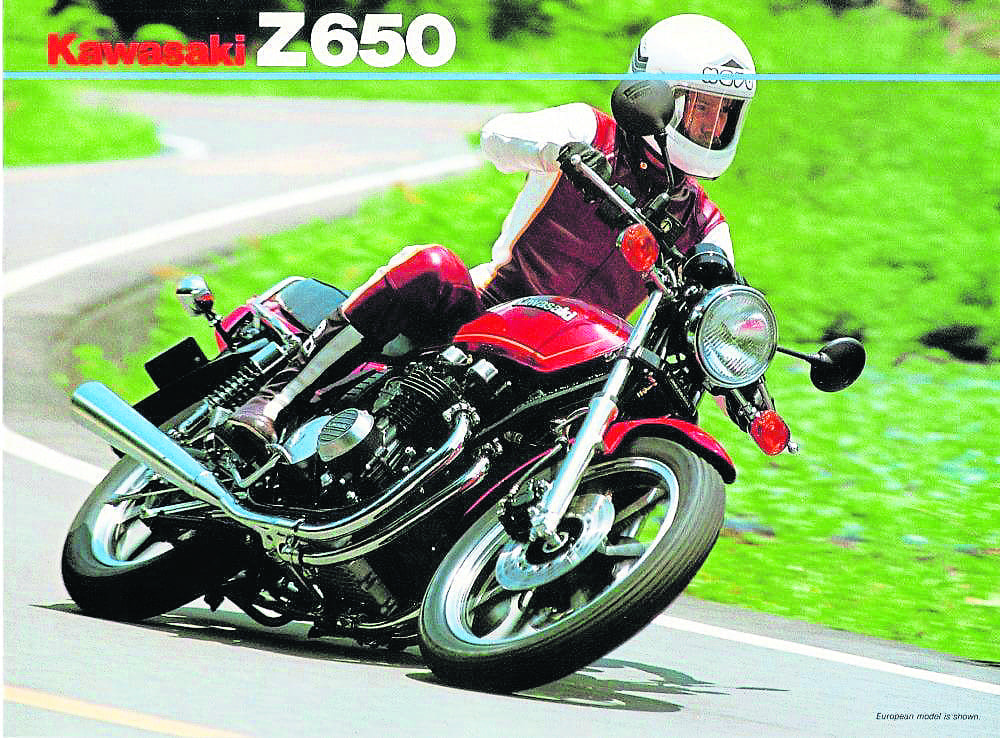Possibly the best VFM classic Japanese four you can buy! Steve Cooper takes a look…
Classic, old-school, air-cooled multis don’t come more attainable than the Z650. Essentially a second generation Japanese four, it has similar performance to Honda’s seminal CB750/4 but with reduced mass… and cost!

Background
Kawasaki’s move into air-cooled fours occurred late 1972 with the iconic Z1 900 Super Four and the bike won hearts and minds… and huge sales. However, it was far from perfect for several reasons: mass, bulk, handling, build costs and more. What was needed was an accessible four that had mass-market appeal and was more cost-effective to build.
The bike
The Z1 900 had been based around a pressed-up crank running roller bearings – a remarkably strong and resilient structure but expensive to build with so many webs, pins, bearings, etc. The Z650’s motor is based around standard automotive practices utilising plain, white metal, big ends and connecting rods bolted together over the bearings. This facet of the bike alone massively reduced the cost of its manufacture, allowing Kawasaki to sell it at a more cost-effective price. And the fact that the firm chose to make its new baby a 650 meant it had no direct market competition.
At the time of launch many questioned why the four-cylinder machine didn’t have four silencers as per the bigger Zeds, but Kawasaki was keen to move the game on. Launched in 1976, the Z650 heralded a move to reduced mass and bulk via 4 into 2 exhaust systems that would feature on the larger machines just a year later. Lessons learnt with the 900s, observations made by various journalists and issues encountered during production racing were all fed back into the 650’s design matrix.

A fundamentally stiffer frame with extra bracing and gusseting formed the basis of the Z650’s better road manners allied to revisions in rake and trail. And the use of just two silencers meant ground clearance was enhanced. Few who rode a Z650 at the time had any real issues with its handling.
What the Z650’s designers achieved is often overlooked or disregarded by fans of the 900s but it’s worth noting especially in the current strained financial times. The 650 is just 5mph slower than the 900; weighs some 20 kilos less; is just 0.1 seconds slower over the standing quarter-mile; and still managed to look like a classic 1970s Zed – and that’s some achievement!
The bike had an eight-year model run (76-83) and was the subject of ongoing upgrades throughout its life. However, all of these changes were iterative and Kawasaki never had any serious issues with any of the models. Interestingly, Kawasaki was amongst the first Japanese manufacturers to launch a so-called ‘factory custom’ version of an existing model. The Z650C was perceived as quite radical for its time with seven-spoked alloy wheels, a chunky rear tyre, pulled-back bars and metallic powder blue paint job. In reality the styling was rather mild but it opened a new market for the bike, especially in the USA.

Lineage and Legacy
The Z650 has a huge legacy and laid down the blueprint for a vast range of air-cooled Kawasakis. It was only with the introduction of the liquid-cooled DOHC, 16-valve GPz900R that things really changed. From the baby Z400J right through the various 750s and on to the hugely impressive GPz1100, the Z650’s DNA was there. Even the hugely outrageous Z750 Turbo has its roots back in the Z650.
Typical Prices
As you might expect with the advent of the new Z650RS, a few dealers are jumping on the bandwagon trying to punt out the original 70s Z650s as something mega-important. There’s enough of the 70s Z/KZ650s to go around and anything over our £5000 budget is, arguably, overpriced. We’ve spotted a handful of the 650C custom models being offered at £8k or more, but that’s pure madness. Five grand tops for something that’s in original condition with OEM exhausts and a standard paint scheme is about where it’s at. Projects start as low as £1500 for something running but rough, and go up to around £2500. We’d be investing £3500-3750 in a USA KZ650 import with patina knowing it’d only likely go up in value.
Why you might want one now
A Kawasaki Z650 offers you pretty much everything a Z1/Z900/Z1000 does but for substantially reduced expenditure. It has all the style and panache of the bigger machines without the mass and bulk, handles significantly better and is substantially more accessible. And with its ‘shim and bucket’ valve clearance adjustment facility, maintenance schedules are reduced. The engine/exhaust are remarkably quiet for the period and the bike is just so easy to ride. Amazingly, it’s still modern-world relevant and, quite frankly, we’d be more that happy to take one touring around Europe.
All the style of a Z900 for a fraction of the cost, less bulk, better handling… what’s not to like? The Z650 offers old-school, air-cooled panache in a readily accessible package allied to the legendary reliability of the four-cylinder Zed range. If you were in the market for a late 70s cum early 80s middleweight you’d genuinely struggle to find something better.
Faults and Foibles
1. VALVE ADJUSTMENT
These motors use inverted ‘shim & bucket’ valve adjustment so a noisy top end may be due to poor maintenance.
2. BRAKES
The original B model had a marginal single disc up front and drum rear. C variants run three discs. All benefit from a proper service and modern pads.
3. EXHAUSTS
Originals are prone to rotting from the inside out. Check on the inner faces and underneath.

4. OIL
It’s a plain bearing bottom end, not rollers like the Z1 so good-quality bike specific oil, and regular filter and oil changes are key to longevity.
5. CARBURETTOR & AIR FILTER
OEM air boxes are always better than pod filters. Haggle accordingly if the air box is missing.
6. SIDE PANELS
A missing panel isn’t the end of the world as replicas are available.
7. GUARDS
Decent front guards are rare. Look out for longer OEM rear guards that have been cut down to ‘look better’. Either guard will now be expensive and rare.
8. PRIMARY CHAIN
Some seem to last forever, others die around 50k. If you’re rebuilding the motor, change the chain regardless.
9. STARTER MOTOR ISSUES
Starter clutches are a known issue and variously caused by low batteries, synthetic oil/additives, weak springs and/or worn parts. Repair components are available but a unit from the later ZR7 fits straight in and works reliably.
#classicbikes #classicbike #classicmotorcycles #kawasaki #z650 #morebikesyoulike #motorcycles #readersrides #motorcycle #ukbikers #bikelife #bikers #motorcyclists #morebikes #morenews #motorcyclenews #motorcyclegear


